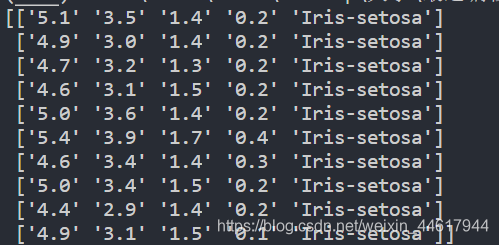- 导入数据
鸢尾属植物数据集 .\iris.data ,在这个数据集中,包括了三类不同的鸢尾属植物:Iris Setosa,Iris Versicolour,Iris Virginica。每类收集了50个样本,因此这个数据集一共包含了150个样本。
outfile=r"C:\Users\15755\Desktop\iris.data"
iris_data = np.loadtxt(outfile, dtype=object, delimiter=',', skiprows=1)
print(iris_data[0:10])

2. 求出鸢尾属植物萼片长度的平均值、中位数和标准差(第1列,sepallength)
把长度单独读取出来
sepalLength = np.loadtxt(outfile, dtype=float, delimiter=',', skiprows=1, usecols=[0])
print(sepalLength[0:10])
# 平均值
print(np.mean(sepalLength))
# 中位数
print(np.median(sepalLength))
# 标准差
print(np.std(sepalLength))
[5.1 4.9 4.7 4.6 5. 5.4 4.6 5. 4.4 4.9]
5.843333333333334
5.8
0.8253012917851409
- 创建一种标准化形式的鸢尾属植物萼片长度,其值正好介于0和1之间,这样最小值为0,最大值为1(第1列,sepallength)。
aMax = np.amax(sepalLength)
aMin = np.amin(sepalLength)
x = (sepalLength - aMin) / (aMax - aMin)
print(x[0:10])
[0.22222222 0.16666667 0.11111111 0.08333333 0.19444444 0.30555556
0.08333333 0.19444444 0.02777778 0.16666667]
- 找到鸢尾属植物萼片长度的第5和第95百分位数(第1列,sepallength)。
x = np.percentile(sepalLength, [5, 95])
print(x)
[4.6 7.255]
- 把iris_data数据集中的20个随机位置修改为np.nan值。
i, j = iris_data.shape
np.random.seed(20201201)
iris_data[np.random.randint(i, size=20)
np.random.randint(j, size=20)] = np.nan
- 在iris_data的sepallength中查找缺失值的个数和位置(第1列)。
np.random.seed(20200621)
iris_data[np.random.randint(i, size=20), np.random.randint(j, size=20)] = np.nan
sepallength = iris_data[:, 0]
x = np.isnan(sepallength)
print(sum(x))
print(np.where(x))
6
(array([ 26, 44, 55, 63, 90, 115], dtype=int64),)
- 筛选具有 sepallength(第1列)< 5.0 并且 petallength(第3列)> 1.5 的 iris_data行。
iris_data = np.loadtxt(outfile, dtype=float, delimiter=',',skiprows=1,usecols=[0, 1, 2,3])
sepallength = iris_data[:, 0]
petallength = iris_data[:, 2]
index = np.where(np.logical_and(petallength > 1.5, sepallength < 5.0))
print(iris_data[index])
[[4.8 3.4 1.6 0.2]
[4.8 3.4 1.9 0.2]
[4.7 3.2 1.6 0.2]
[4.8 3.1 1.6 0.2]
[4.9 2.4 3.3 1. ]
[4.9 2.5 4.5 1.7]]
- 选择没有任何 nan 值的 iris_data行。
iris_data = np.loadtxt(outfile, dtype=float, delimiter=',', skiprows=1,usecols=[0, 1, 2,3])
i, j = iris_data.shape
np.random.seed(20200621)
iris_data[np.random.randint(i, size=20), np.random.randint(j, size=20)] = np.nan
x = iris_data[np.sum(np.isnan(iris_data), axis=1) == 0]
print(x[0:10])
[[5.1 3.5 1.4 0.2]
[4.9 3. 1.4 0.2]
[4.7 3.2 1.3 0.2]
[4.6 3.1 1.5 0.2]
[5. 3.6 1.4 0.2]
[4.6 3.4 1.4 0.3]
[5. 3.4 1.5 0.2]
[4.9 3.1 1.5 0.1]
[5.4 3.7 1.5 0.2]
[4.8 3.4 1.6 0.2]]
- 计算 iris_data 中sepalLength(第1列)和petalLength(第3列)之间的相关系数。
iris_data = np.loadtxt(outfile, dtype=float, delimiter=',', skiprows=1,usecols=[0, 1, 2,3])
sepalLength = iris_data[:, 0]
petalLength = iris_data[:, 2]
m1 = np.mean(sepalLength)
m2 = np.mean(petalLength)
sepalLength = iris_data[:, 0]
petalLength = iris_data[:, 2]
x = np.mean((sepalLength - m1) * (petalLength - m2))
y = np.std(sepalLength) * np.std(petalLength)
print(x / y)
0.8717541573048712
- 找出iris_data是否有任何缺失值。
iris_data = np.loadtxt(outfile, dtype=float, delimiter=',', skiprows=1, usecols=[0, 1, 2,3])
x = np.isnan(iris_data)
print(np.any(x))
False
- 在numpy数组中将所有出现的nan替换为0。
iris_data = np.loadtxt(outfile, dtype=float, delimiter=',', skiprows=1, usecols=[0, 1, 2,3])
i, j = iris_data.shape
np.random.seed(20200621)
iris_data[np.random.randint(i, size=20), np.random.randint(j, size=20)] = np.nan
iris_data[np.isnan(iris_data)] = 0
print(iris_data[0:10])
[[5.1 3.5 1.4 0.2]
[4.9 3. 1.4 0.2]
[4.7 3.2 1.3 0.2]
[4.6 3.1 1.5 0.2]
[5. 3.6 1.4 0.2]
[5.4 0. 1.7 0.4]
[4.6 3.4 1.4 0.3]
[5. 3.4 1.5 0.2]
[4.4 2.9 0. 0.2]
[4.9 3.1 1.5 0.1]]
- 找出鸢尾属植物物种中的唯一值和唯一值出现的数量。
iris_data = np.loadtxt(outfile, dtype=object, delimiter=',', skiprows=1, usecols=[4])
x = np.unique(iris_data, return_counts=True)
print(x)
(array(['Iris-setosa', 'Iris-versicolor', 'Iris-virginica'], dtype=object), array([50, 50, 50], dtype=int64))
- 将 iris_data 的花瓣长度(第3列)以形成分类变量的形式显示。定义:Less than 3 -->‘small’;3-5 --> ‘medium’;’>=5 --> ‘large’。
iris_data = np.loadtxt(outfile, dtype=float, delimiter=',', skiprows=1, usecols=[0, 1, 2,3])
petal_length_bin = np.digitize(iris_data[:, 2], [0, 3, 5, 10])
label_map = {1: 'small', 2: 'medium', 3: 'large', 4: np.nan}
petal_length_cat = [label_map[x] for x in petal_length_bin]
print(petal_length_cat[0:10])
['small', 'small', 'small', 'small', 'small', 'small', 'small', 'small', 'small', 'small']
- 在 iris_data 中创建一个新列,其中 volume 是 (pi x petallength x sepallength ^ 2)/ 3 。
iris_data = np.loadtxt(outfile, dtype=object, delimiter=',', skiprows=1)
sepalLength = iris_data[:, 0].astype(float)
petalLength = iris_data[:, 2].astype(float)
volume = (np.pi * petalLength * sepalLength ** 2) / 3
volume = volume[:, np.newaxis]
iris_data = np.concatenate([iris_data, volume], axis=1)
print(iris_data[0:10])
[['5.1' '3.5' '1.4' '0.2' 'Iris-setosa' 38.13265162927291]
['4.9' '3.0' '1.4' '0.2' 'Iris-setosa' 35.200498485922445]
['4.7' '3.2' '1.3' '0.2' 'Iris-setosa' 30.0723720777127]
['4.6' '3.1' '1.5' '0.2' 'Iris-setosa' 33.238050274980004]
['5.0' '3.6' '1.4' '0.2' 'Iris-setosa' 36.65191429188092]
['5.4' '3.9' '1.7' '0.4' 'Iris-setosa' 51.911677007917746]
['4.6' '3.4' '1.4' '0.3' 'Iris-setosa' 31.022180256648003]
['5.0' '3.4' '1.5' '0.2' 'Iris-setosa' 39.269908169872416]
['4.4' '2.9' '1.4' '0.2' 'Iris-setosa' 28.38324242763259]
['4.9' '3.1' '1.5' '0.1' 'Iris-setosa' 37.714819806345474]]
- 随机抽鸢尾属植物的种类,使得Iris-setosa的数量是Iris-versicolor和Iris-virginica数量的两倍。
species = np.array(['Iris‐setosa', 'Iris‐versicolor', 'Iris‐virginica'])
species_out = np.random.choice(species, 10000, p=[0.5, 0.25, 0.25])
print(np.unique(species_out, return_counts=True))
(array(['Iris‐setosa', 'Iris‐versicolor', 'Iris‐virginica'], dtype='<U15'), array([5024, 2468, 2508], dtype=int64))
- 根据 sepallength 列对数据集进行排序。
iris_data = np.loadtxt(outfile, dtype=object, delimiter=',', skiprows=1)
sepalLength = iris_data[:, 0]
index = np.argsort(sepalLength)
print(iris_data[index][0:10])
[['4.3' '3.0' '1.1' '0.1' 'Iris-setosa']
['4.4' '3.2' '1.3' '0.2' 'Iris-setosa']
['4.4' '3.0' '1.3' '0.2' 'Iris-setosa']
['4.4' '2.9' '1.4' '0.2' 'Iris-setosa']
['4.5' '2.3' '1.3' '0.3' 'Iris-setosa']
['4.6' '3.6' '1.0' '0.2' 'Iris-setosa']
['4.6' '3.1' '1.5' '0.2' 'Iris-setosa']
['4.6' '3.4' '1.4' '0.3' 'Iris-setosa']
['4.6' '3.2' '1.4' '0.2' 'Iris-setosa']
['4.7' '3.2' '1.3' '0.2' 'Iris-setosa']]
- 在鸢尾属植物数据集中找到最常见的花瓣长度值(第3列)。
iris_data = np.loadtxt(outfile, dtype=object, delimiter=',', skiprows=1)
petalLength = iris_data[:, 2]
vals, counts = np.unique(petalLength, return_counts=True)
print(vals[np.argmax(counts)])
print(np.amax(counts))
1.5
14
- 在鸢尾花数据集的 petalwidth(第4列)中查找第一次出现的值大于1.0的位置。
iris_data = np.loadtxt(outfile, dtype=float, delimiter=',', skiprows=1, usecols=[0, 1, 2,3])
petalWidth = iris_data[:, 3]
index = np.where(petalWidth > 1.0)
print(index)
print(index[0][0])
(array([ 50, 51, 52, 53, 54, 55, 56, 58, 59, 61, 63, 64, 65,
66, 68, 69, 70, 71, 72, 73, 74, 75, 76, 77, 78, 80,
82, 83, 84, 85, 86, 87, 88, 89, 90, 91, 92, 94, 95,
96, 97, 98, 99, 100, 101, 102, 103, 104, 105, 106, 107, 108,
109, 110, 111, 112, 113, 114, 115, 116, 117, 118, 119, 120, 121,
122, 123, 124, 125, 126, 127, 128, 129, 130, 131, 132, 133, 134,
135, 136, 137, 138, 139, 140, 141, 142, 143, 144, 145, 146, 147,
148, 149], dtype=int64),)
50





















 95
95











 被折叠的 条评论
为什么被折叠?
被折叠的 条评论
为什么被折叠?








